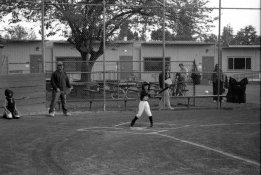chuck94022
Member
I've been following my son around lately with a Nikon N70 using bulk loaded Tri-X.
Yesterday he had his annual spring play. I shot out the last couple of frames of the Tri-X that had been in the camera, shot at the rated speed (400). I loaded a new roll, and because I wanted to shoot available light, decided to push this roll two stops to 1600. (My wife was next to me with her little digicam, so I wasn't that worried about losing all records of this event if I screwed up...)
I shot the roll, and before leaving the school loaded a new roll of Tri-X and reset my camera back to the rated speed.
When I got home I realized I had forgotten to identify the pushed roll. Oops.
I decided that the shots of the play were more important than whatever was on the other roll (I wasn't sure but it was probably random little league shots). So I decided to process both rolls pushed to 1600 (in D76 non-diluted for 13 minutes, normal agitation). I figured the play shots would come out OK, and the other shots would be ruined.
I was very pleased with the shots of the play. This was my first time pushing Tri-X, and I think it performed beautifully.
I was also pleasantly surprised with the quality of the overdeveloped roll. While it is too grainy, the shots are useable, and I'm glad they are - I had some really good memories on that roll.
I've attached two shots: The baseball shot is a negative scan (tweaked only to correct for scanner lossiness) from the overdeveloped roll. The play shot is from the pushed and correctly developed roll.
According to my cheat sheet for Tri-X, the baseball shot should have only been in the soup for 8 minutes. Instead it got an extra 5 minutes. I'm pretty impressed with how the image held up, given that. Of course, I don't like the grain in that roll, but at least the images are salvageable. They won't win any awards, but they certainly preserve some great moments in my son's childhood!
[Edit: He was a hermit crab in the play, which expains the backpack and the claw...]
Yesterday he had his annual spring play. I shot out the last couple of frames of the Tri-X that had been in the camera, shot at the rated speed (400). I loaded a new roll, and because I wanted to shoot available light, decided to push this roll two stops to 1600. (My wife was next to me with her little digicam, so I wasn't that worried about losing all records of this event if I screwed up...)
I shot the roll, and before leaving the school loaded a new roll of Tri-X and reset my camera back to the rated speed.
When I got home I realized I had forgotten to identify the pushed roll. Oops.
I decided that the shots of the play were more important than whatever was on the other roll (I wasn't sure but it was probably random little league shots). So I decided to process both rolls pushed to 1600 (in D76 non-diluted for 13 minutes, normal agitation). I figured the play shots would come out OK, and the other shots would be ruined.
I was very pleased with the shots of the play. This was my first time pushing Tri-X, and I think it performed beautifully.
I was also pleasantly surprised with the quality of the overdeveloped roll. While it is too grainy, the shots are useable, and I'm glad they are - I had some really good memories on that roll.
I've attached two shots: The baseball shot is a negative scan (tweaked only to correct for scanner lossiness) from the overdeveloped roll. The play shot is from the pushed and correctly developed roll.
According to my cheat sheet for Tri-X, the baseball shot should have only been in the soup for 8 minutes. Instead it got an extra 5 minutes. I'm pretty impressed with how the image held up, given that. Of course, I don't like the grain in that roll, but at least the images are salvageable. They won't win any awards, but they certainly preserve some great moments in my son's childhood!
[Edit: He was a hermit crab in the play, which expains the backpack and the claw...]












